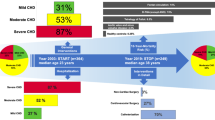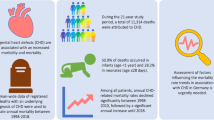Abstract
Limited data are available on the survival of patients with Down syndrome and congenital heart disease (CHD) from middle-income countries. This retrospective cohort study was performed to determine the trends in the prevalence and survival of such patients born from January 2006 to December 2015 in Malaysia. Among 754 patients with Down syndrome, 414 (55%) had CHD, and no significant trend was observed during the 10 years. Of these 414 patients, 30% had lesions that closed spontaneously, 35% underwent surgery/intervention, 9% died before surgery/intervention, and 10% were treated with comfort care. The overall mortality rate was 23%, the median age at death was 7.6 months, and no significant changes occurred over time. The early and late post-surgery/intervention mortality rates were 0.7% and 9.0%, respectively. Most deaths were of non-cardiac causes. The overall 1-, 5-, and 10-year survival rates were 85.5%, 74.6%, and 72.9%, respectively. Patients with severe lesions, persistent pulmonary hypertension of the newborn, atrioventricular septal defect, and pulmonary hypertension had low survival at 1 year of age.
Conclusion: The prevalence of CHD in patients with Down syndrome is similar between Malaysia and high-income countries. The lower survival rate is attributed to limited expertise and resources which limit timely surgery.
What is Known: • The survival of patients with Down syndrome with congenital heart disease (CHD) has improved in high-income countries. However, little is known about the survival of patients with Down syndrome with CHD from middle-income countries. • In the Caucasian population, atrioventricular septal defect is the most common type of CHD associated with Down syndrome. | |
What is New: • In middle-income countries, the prevalence of CHD is the same as in high-income countries, but with a lower survival rate. • In the Asian population, ventricular septal defect is the most common type of CHD in patients with Down syndrome. |

Similar content being viewed by others
Abbreviations
- ASD:
-
Atrial septal defect
- AVSD:
-
Atrioventricular septal defect
- CHD:
-
Congenital heart disease
- CI:
-
Confidence interval
- HSAJB:
-
Hospital Sultanah Aminah Johor Bahru
- IQR:
-
Interquartile range
- LMICs:
-
Low- and middle-income countries
- PDA:
-
Patent ductus arteriosus
- PHT:
-
Pulmonary hypertension
- PPHN:
-
Persistent pulmonary hypertension of the newborn
- PS:
-
Pulmonary stenosis
- UMMC:
-
University Malaya Medical Centre
- VSD:
-
Ventricular septal defect
References
Bergstrom S, Carr H, Petersson G, Stephansson O, Bonamy AK, Dahlstrom A, Halvorsen CP, Johansson S (2016) Trends in congenital heart defects in infants with Down syndrome. Pediatrics 138:e20160123
Brodwall K, Greve G, Leirgul E, Klungsøyr K, Holmstrøm H, Vollset SE, Øyen N (2018) The five-year survival of children with Down syndrome in Norway 1994–2009 differed by associated congenital heart defects and extracardiac malformations. Acta Paediatr 107:845–853
Bush D, Galambos C, Ivy DD, Abman SH, Wolter-Warmerdam K, Hickey F (2018) Clinical characteristics and risk factors for developing pulmonary hypertension in children with Down syndrome. J Pediatr 202:212–219
Cua CL, Blankenship A, North AL, Hayes J, Nelin LD (2007) Increased incidence of idiopathic persistent pulmonary hypertension in Down syndrome neonates. Pediatr Cardiol 28:250–254
Dhillon R (2012) The management of neonatal pulmonary hypertension. Arch Dis Child Fetal Neonatal Ed 97:F223–F228
Fudge JC Jr, Li S, Jaggers J, O’Brien SM, Peterson ED, Jacobs JP, Welke KF, Jacobs ML, Li JS, Pasquali SK (2010) Congenital heart surgery outcomes in Down syndrome: analysis of a national clinical database. Pediatrics 126:315–322
Glasson EJ, Jacques A, Wong K, Bourke J, Leonard H (2016) Improved survival in Down syndrome over the last 60 years and the impact of perinatal factors in recent decades. J Pediatr 169:214–220
Hayes C, Johnson Z, Thornton L, Fogarty J, Lyons R, O’Connor M, Delany V, Buckley K (1997) Ten-year survival of Down syndrome births. Int J Epidemiol 26:822–829
Hoashi T, Hirahara N, Murakami A, Hirata Y, Ichikawa H, Kobayashi J, Takamoto S (2018) Current surgical outcomes of congenital heart surgery for patients with Down syndrome in Japan. Circ J 82:403–408
Hoffman JI, Kaplan S (2002) The incidence of congenital heart disease. J Am Coll Cardiol 39:1890–1900
Irving CA, Chaudhari MP (2012) Cardiovascular abnormalities in Down’s syndrome: spectrum, management and survival over 22 years. Arch Dis Child 97:326–330
Irving C, Basu A, Richmond S, Burn J, Wren C (2008) Twenty-year trends in prevalence and survival of Down syndrome. Eur J Hum Genet 16:1336–1340
Jenkins KJ, Castañeda AR, Cherian KM, Couser CA, Dale EK, Gauvreau K, Hickey PA, Koch Kupiec J, Morrow DF, Novick WM et al (2014) Reducing mortality and infections after congenital heart surgery in the developing world. Pediatrics 134:e1422–e1430
Körten MA, Helm PC, Abdul-Khaliq H, Baumgartner H, Kececioglu D, Schlensak C, Bauer UM, Diller GP (2016) Eisenmenger syndrome and long-term survival in patients with Down syndrome and congenital heart disease. Heart 102:1552–1557
Kucik JE, Shin M, Siffel C, Marengo L, Correa A (2013) Trends in survival among children with Down syndrome in 10 regions of the United States. Pediatrics 131:e27–e36
Masuda M, Kado H, Tanoue Y, Fukae K, Onzuka T, Shiokawa Y, Shirota T, Yasui H (2005) Does Down syndrome affect the long-term results of complete atrioventricular septal defect when the defect is repaired during the first year of life? Eur J Cardiothorac Surg 27:405–409
Mat Bah MN, Sapian MH, Jamil MT, Abdullah N, Alias EY, Zahari N (2018) The birth prevalence, severity, and temporal trends of congenital heart disease in the middle-income country: a population-based study. Congenit Heart Dis 13:1012–1027
Mat Bah MN, Sapian MH, Jamil MT, Alias A, Zahari N (2018) Survival and associated risk factors for mortality among infants with critical congenital heart disease in a developing country. Pediatr Cardiol 39:1389–1396
Mitchell S, Korones SB, Berendes HW (1971) Congenital heart disease in 56,109 births. Incidence and natural history. Circulation 43:323–332
Mocumbi AO, Lameira E, Yaksh A, Paul L, Ferreira MB, Sidi D (2011) Challenges on the management of congenital heart disease in developing countries. Int J Cardiol 148:285–288
Musa NL, Hjortdal V, Zheleva B, Murni IK, Sano S, Schwartz S, Staveski SL (2017) The global burden of paediatric heart disease. Cardiol Young 27:S3–S8
Narayanan DL, Yesodharan D, Kappanayil M, Kuthiroly S, Thampi MV, Hamza Z, Anilkumar A, Nair KM, Sundaram KR, Kumar RK, Nampoothiri S (2014) Cardiac spectrum, cytogenetic analysis and thyroid profile of 418 children with Down syndrome from South India: a cross-sectional study. Indian J Pediatr 81:547–551
Pfitzer C, Helm PC, Rosenthal LM, Berger F, Bauer UMM, Schmitt KR (2017) Dynamics in prevalence of Down syndrome in children with congenital heart disease. Eur J Pediatr 177:107–115
Plaiasu V (2017) Down syndrome - genetics and cardiogenetics. Maedica (Buchar) 12:208–213
Roofthooft MT, Elema A, Bergman KA, Berger RM (2011) Patient characteristics in persistent pulmonary hypertension of the newborn. Pulm Med 2011:858154
Shah PS, Hellmann J, Adatia I (2004) Clinical characteristics and follow up of Down syndrome infants without congenital heart disease who presented with persistent pulmonary hypertension of newborn. J Perinat Med 32:168–170
Steurer MA, Jelliffe-Pawlowski LL, Baer RJ, Partridge JC, Rogers EE, Keller RL (2017) Persistent pulmonary hypertension of the newborn in late preterm and term infants in California. Pediatrics 139:e20161165
Tan M, Xu C, Sim SK, Seow AL, Tan TH, Quek SC (2013) Types and distribution of congenital heart defects associated with trisomy 21 in Singapore. J Paediatr Child Health 49:223–227
Tumanyan MR, Filaretova OV, Chechneva VV, Gulasaryan RS, Butrim IV, Bockeria LA (2015) Repair of complete atrioventricular septal defect in infants with down syndrome: outcomes and long-term results. Pediatr Cardiol 36:71–75
van der Linde D, Konings EE, Slager MA, Witsenburg M, Helbing WA, Takkenberg JJ, Roos-Hesselink JW (2011) Birth prevalence of congenital heart disease worldwide: a systematic review and meta-analysis. J Am Coll Cardiol 58:2241–2247
Weijerman ME, van Furth AM, van der Mooren MD, van Weissenbruch MM, Rammeloo L, Broers CJ, Gemke RJ (2010) Prevalence of congenital heart defects and persistent pulmonary hypertension of the neonate with Down syndrome. Eur J Pediatr 169:1195–1199
World Health Organization (2010) Birth defects. Sixty-third World Health Assembly. WHO, Geneva, pp 1–7 http://apps.who.int/gb/ebwha/pdf_files/WHA63/A63_10-EN.PDF. Accessed 1 Feb 2015
Wu MH, Chen HC, Lu CW, Wang JK, Huang SC, Huang SK (2010) Prevalence of congenital heart disease at live birth in Taiwan. J Pediatr 156:782–785
Acknowledgments
We would like to acknowledge all the staff in the pediatric cardiology and genetic departments of the University Malaya Medical Centre and Hospital Sultanah Aminah Johor Bahru, Clinical Research Centre HSAJB, for their help in the data collection. We also thank the Director General of Health Malaysia for his permission to publish this article. Finally, we thank Angela Morben, DVM, ELS, from Edanz Group (www.edanzediting.com/ac), for editing a draft of this manuscript.
Author information
Authors and Affiliations
Contributions
Dr. HR was involved in data entry and analysis and drafted the initial manuscript.
Dr. NZ conceptualized and designed the study, carried out the echocardiogram, and revised the manuscript.
Dr. MNMB conceptualized and designed the study, carried out the echocardiogram, analyzed the data, and revised the manuscript.
Prof TMK reviewed the manuscript for important intellectual content and revised the manuscript.
All authors approved the final manuscript as submitted and agree to be accountable for all the aspects of the work.
Corresponding author
Ethics declarations
Conflict of interest
The authors declare that they have no conflict of interest.
Ethical approval
All procedures performed in studies involving human participants were in accordance with the clinical standards of the institutional and/or national research committee and with the 1964 Helsinki Declaration and its later amendments or comparable ethical standards. The study was approved by the Medical Research and Ethics Committee of Ministry of Health Malaysia (NMRR-17-957-35260(IIR)) and University Malaya Medical Centre (MREC ID NO: 201723-4886).
Additional information
Communicated by Peter de Winter
Publisher’s note
Springer Nature remains neutral with regard to jurisdictional claims in published maps and institutional affiliations.
Rights and permissions
About this article
Cite this article
Zahari, N., Mat Bah, M.N., A. Razak, H. et al. Ten-year trend in prevalence and outcome of Down syndrome with congenital heart disease in a middle-income country. Eur J Pediatr 178, 1267–1274 (2019). https://doi.org/10.1007/s00431-019-03403-x
Received:
Revised:
Accepted:
Published:
Issue Date:
DOI: https://doi.org/10.1007/s00431-019-03403-x




